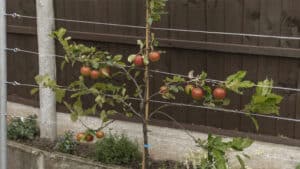 As urban living becomes increasingly popular, many Oklahoma City homeowners find themselves with limited outdoor space, making it challenging to cultivate a traditional garden. Fortunately, you don’t need a sprawling estate to enjoy the sweetness of homegrown fruits. At River Bottom Nursery, we believe that even the smallest yards can accommodate fruit trees with the right planning and techniques. Here are some tips on how you can successfully plant fruit trees in your limited outdoor space.
As urban living becomes increasingly popular, many Oklahoma City homeowners find themselves with limited outdoor space, making it challenging to cultivate a traditional garden. Fortunately, you don’t need a sprawling estate to enjoy the sweetness of homegrown fruits. At River Bottom Nursery, we believe that even the smallest yards can accommodate fruit trees with the right planning and techniques. Here are some tips on how you can successfully plant fruit trees in your limited outdoor space.
When selecting fruit trees for planting in smaller yards, it’s crucial to choose varieties that are suitable for limited space. Dwarf and semi-dwarf trees are excellent options as they typically grow to a height of 8 to 10 feet, making them manageable in smaller areas. Popular dwarf varieties include:
Dwarf Apple Trees: Compact and productive, these trees can yield a generous harvest without taking up too much space.
Peach Trees: Dwarf peach trees are not only beautiful but also produce delicious fruit in a small footprint.
Fig Trees: These can be grown in pots, or trained as bushes, making them perfect for patios and small yards.
Maximize your planting space by using vertical gardening techniques. Espalier is a method of training trees to grow flat against a wall or fence, allowing you to save ground space while creating a stunning visual element in your yard. Additionally, consider planting trees in containers or raised beds. Containers allow for easy mobility and can be placed in sunny spots to ensure your trees receive adequate sunlight.
Fruit trees thrive in bright, direct sunlight. Ensure that your selected planting location receives at least six to eight hours of sunlight each day. If your yard has shaded areas, consider trimming back overhanging branches or selecting trees that can tolerate partial shade. Remember, sufficient sunlight is key to producing healthy, fruitful trees.
Before planting your fruit trees, it’s essential to prepare the soil. Test your soil for pH levels and nutrient content. Most fruit trees prefer well-draining soil with a slightly acidic to neutral pH. Amend your soil with organic matter, such as compost, to enhance its fertility and drainage capabilities.
When planting, dig a hole that is twice as wide as the root ball but no deeper than the root ball itself. Gently place the tree in the hole, ensuring that the graft union (where the tree variety was grafted onto the rootstock) is above the soil line. Backfill with soil, water thoroughly, and apply a layer of mulch to retain moisture and suppress weeds.
Regular watering is crucial, especially during the first few years as your trees establish their root systems. Aim to keep the soil consistently moist but not waterlogged. As the trees mature, adjust your watering schedule according to seasonal rainfall.
Routine maintenance, including pruning and fertilizing, will promote healthy growth and fruit production. Prune your trees in late winter or early spring to remove dead or overcrowded branches, which will improve air circulation and sunlight penetration.
Planting fruit trees in smaller yards can be a rewarding experience that provides both aesthetic beauty and delicious produce. By selecting the right varieties, optimizing your planting space, and following proper care techniques, you can successfully cultivate a fruitful oasis in your compact outdoor environment. At River Bottom Nursery, we are here to guide you through every step of your gardening journey. Visit us today for expert advice on planting fruit trees in your backyard and to explore our selection of fruit trees perfect for small spaces! Happy planting!